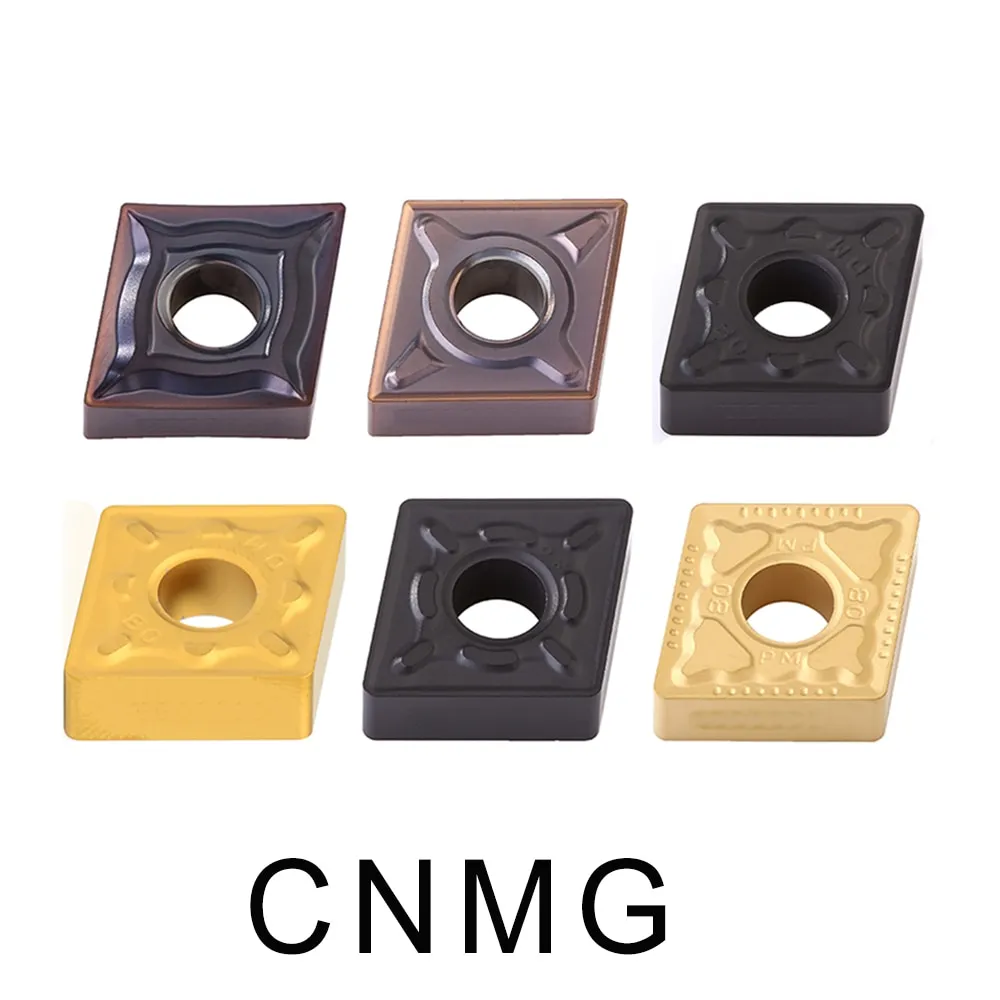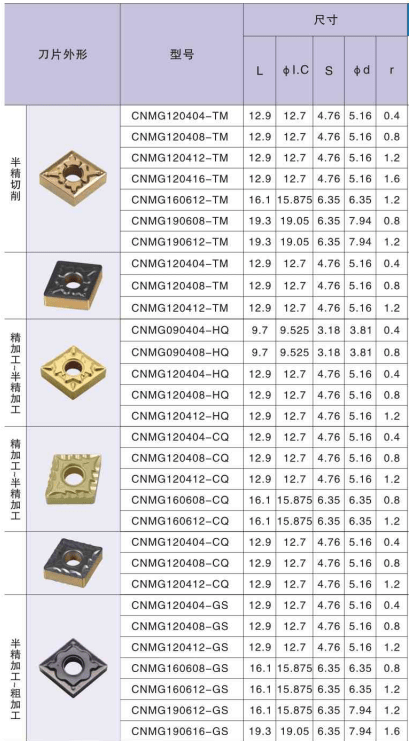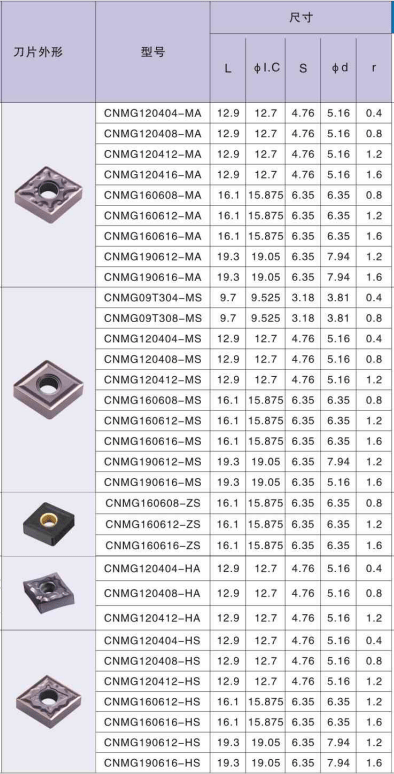Looking for CNMG insert? CNMG inserts that may be used in the cutting of a variety of materials, including wood, metal, and others. Drilling, milling, and turning are just some of the CNC techniques that this material is compatible with. Both the CNMG 190612 insert and the CNC tool lathe make use of this component. In the meanwhile, it is suitable for use with computer numerical control (CNC) machine machines, machining centers, and other similar devices. The primary body of the CNMG 642 is made out of steel, and the blade has a longer service life than similar products on the market. CNMG turning inserts are used as the principal component materials due to their respective high levels of hardness, high strength, strong toughness, exceptional toughness, and long service lives. At this moment, it is suitable for use with CNC lathes, milling machines, and drilling machines.
CNMG inserts are used extensively across a variety of processing equipment, including but not limited to machining centers, boring head holders, tool holders, and others. In the meanwhile, HUANA CNMG inserts have been added in order to facilitate the rapid rotation of the blade. CNMG 190612 inserts have a robust structure, which enables them to function at a higher level and last for a longer period of time in service. HUANA is the place to go if you want to acquire best CNMG insert for stainless steel at a price that is within your budget. Given the variety of deals that are now being offered, it is our mission to make it easier for you to take advantage of as many of the savings as is humanly feasible. At HUANA, you may kick your feet up and take it easy as you browse. Our objective is to simplify and expedite the steps involved in making an online purchase as much as is humanly practicable.
Models of CNMG Turning Inserts
The performance of the next generation turning insert, model number CNMG120408, is superior in every manner. They are suggested for continuous as well as interrupted cuts since they are coated with technology that is of the second generation and have a wide variety of uses.
The top selection The CNMG120404 has greatly increased levels of wear resistance, heat resistance, and hardness, hence widening the application range significantly. There is a need for increased heat resistance in both CNMG120408 and CNMG120404. When machining is performed under controlled circumstances, it enables a fast-cutting speed as well as lengthy durations in cut.
Variety of Chipbreakers Styles
HUANA are equipped with best CNMG insert for stainless steel that come in a variety of chipbreaker styles.
In the not-too-distant past, inserts did not have chip breakers. If both the component and the set-up had flat tops, then any and all inserts would function. This resulted in a great deal of problems with chips that were inflexible, despite the fact that the machine had sufficient horse control. Turning presented a unique challenge since, in many instances, power was limited and the material did not have a “sticky” quality; as a result, turning was a continuous process that produced chips that were lengthy and stringy.
Milling, on the other hand, was termed an interrupted cut, and the chips produced were shorter than those produced by turning since the insert only cut for half a revolution during milling. Turning inserts were the natural starting point for the development of chip-breakers in cutting tools.
The first chip-breakers worked by curling the chip and applying pressure to cause it to shatter. This was their principal purpose. However, the “G” type chip-breakers were the only ones that were available. For example, CNMG, etc.
Chipbreakers of the TM, MA, HQ, and PM styles are available as Huana Turning Inserts.
Huana has added TM, MA, HQ, and PM type chipbreakers to its best CNMG insert for stainless steel, making it the next generation of turning inserts available.
In steel turning applications, the Huana series has been shown to be an effective option for maintaining process security while maximizing tool life. The series now contains new chipbreakers for its negative insert lines, with styles TM, MA, HQ, and PM for cutting. These Chipbreakers are intended to further improve the grades’ performance across a wide variety of application areas.
- MA Chipbreaker
The MA style chipbreaker, which was developed for finish turning, features a large inclination angle on the cutting edge and a newly designed chipbreaker that together offer improved chip control during machining at light depths of cut. These characteristics were included in the design of the chipbreaker. Because of its one-of-a-kind geometric design, it is able to provide a long and predictable tool life while preventing crater wear from accumulating on the rake face. This is particularly useful when machining at greater feed rates, which yields thicker chips.
- HQ Chipbreaker
Chipbreaker styles of high quality allow for steady machining across a broad variety of application domains.
- PM Chipbreaker
The PM style is a flexible chipbreaker for medium cutting that incorporates an improved cutting edge and chip pocket profile to provide excellent chip control across a broad parameter range. This type of chipbreaker is designated by the designation PM.
- TM Chipbreaker
When finishing aluminum, it provides a surface finish that is of excellent quality. A chipbreaker that has been optimized offers improved chip control.
The ability of the CNMG inserts chip-breaker to block the heat from the chip from entering the insert was yet another benefit offered by this component. When using an insert with a flat top, the hot chip would glide over the face of the insert, and the heat from the chip would be transmitted into the insert, which would limit the life of the tool.
With chip-breakers, a tiny “single bump” or groove would limit the amount of contact the chip had with the insert. As a result, the amount of heat passed into the insert would be reduced, which would lengthen the life of the tool. There was a significant gap in performance brought on by seemingly little variations in chip-breakers.
Insert makers separate themselves from one another by making use of their own unique chip breakers. The labels were removed from turning inserts, and instead, generic breakers with the new chip-breaker names were added to the description, such as best CNMG insert for stainless steel.
How to choose the appropriate CNMG turning insert?
It is feasible to optimize machining conditions, minimize machining time, increase machining efficiency, assure the quality of the workpiece that is being machined, and prolong the service life of the tool by making a reasonable selection of CNMG 432 insert geometry. Choose the appropriate angle for the CNMG insert based on the kind of tool you are using.
When it comes to selecting the appropriate turning insert, finding the insert that is most suited to the task at hand is just half the fight. The last step consists of choosing the most appropriate grade and chip breaker.
In the following paragraphs, we will explain how to go about picking the most appropriate CNMG insert shape and grade for the particular duties you have.
Insert shape, geometry, grade, and other factors are only some of the numerous factors that should be considered when selecting the appropriate insert for your turning operations. The objective is to find an insert that satisfies your needs for both quality and performance while also delivering effective chip control and a level of wear resistance and tensile strength that is commensurate with industry standards.
Insert style The characteristics of the portion and the depth of cut that you want to achieve should guide your decision about the insert style (shape and size). Larger nose radii are stronger, but they need more machine power and increase the likelihood that they may vibrate. A lower nose radius allows for more access to fine component details, but it results in a cutting edge that is less robust.
Determine the kind of chipbreaker (geometry) to use depending on the type of machining operation you will be performing: finishing, medium, or roughing. When roughing with high depths of cut and feedrates, the insert you use must have a cutting edge that is more durable.
Finishing processes that have shallow depths of cut and slower feedrates provide less cutting force, which means that cutting-edge strength is not as significant in these situations. Medium turning operations demand a more adaptable geometry since they have a wider variety of depths of cut and feedrates to accommodate.
Turning Insert Grades By Material
The act of turning, which is part of the machining process, involves a cutting tool called a bit that travels in a linear fashion while the workpiece rotates. The choice of CNMG 432 turning insert is highly influenced by the type of material being worked with. It is of the utmost importance to select a turning material of an appropriate grade, such as hardened steel. It requires insert grades that are exceptionally durable and stiff.
Always keep an eye out for CNMG grades that have the capacity to handle high temperatures and a significant amount of force while cutting, as this will allow you to identify items with exceptional durability. When stainless steel is turned, there is typically significant friction and heat generated as a result of the process. Because of this, it is extremely important to choose turning grades that are able to endure heat and give a long and robust life. Turning grades that are very productive can survive the high temperatures generated by turning these materials without suffering any edge loss.
You should choose the insert grade (coatings) depending on the kind of material that is being cut, the exact machining operation that is being performed (finishing, medium, or roughing), and the cutting circumstances (smooth, lightly interrupted, heavily interrupted). The insert grade and the chip breaker work together to produce certain performance qualities, which are complemented by one another. A grade that is more wear resistant may give longer tool life on a cutting edge that is already strong, while a grade that is harder can compensate for a cutting edge that already has less strength.
HUANA CNMG Turning Insert
When it comes to the extensive assortment of CMNG turning inserts and chipbreakers that HUANA has to offer, everything is feasible. We created each of these solutions, which include CMNG inserts of varying forms, sizes, and thicknesses, with the same objective in mind: to increase the productivity and tool life in your turning applications. This extensive selection, which encompasses all material groups, makes it possible for you to accomplish your objectives in terms of the rates of material removal, the tool life, and the surface quality.
During the profile turning or face turning processes, chip jamming and re-cutting can be a common challenge when the cutting is performed in the direction away from the work centre in one continuous path. This is because conventional CNMG 642 or DNMG turning inserts are made of a material called CNMG, which is a form of DNMG.
In comparison to conventional CNMG inserts, HUANA’s newly developed CNMG 642 inserts each have an angle that is less acute. When facing turning the wall, the additional space on the cutting edge allows for improved chip flow and reduces the likelihood of chip re-cutting difficulties occurring. A decreased nose angle also helps to reduce cutting force, which helps to reduce unpredictability in tool failure as well as chatter during the machining process. The new inserts come in a variety of chipbreaker types, including as TM, MA, HQ, and PM type chipbreakers, which may be used for finish turning as well as general purpose applications. Inserts from CNMG are available in the newest generation of grades, which are designed for use in steel turning for high temperature alloys.
Conclusion
In conclusion, as a result of the development of modern technology, the HUANA CNMG turning inserts have also changed from the traditional welding turning tools to the machine-clamp turning inserts, as well as the CNMG 642 turning insert for standard CNC blades that are commonly used these days; The increasing popularity of high-speed CNMG Inserts has improved production efficiency, ensured the precision of cutting, and extended the service life of the blades.




